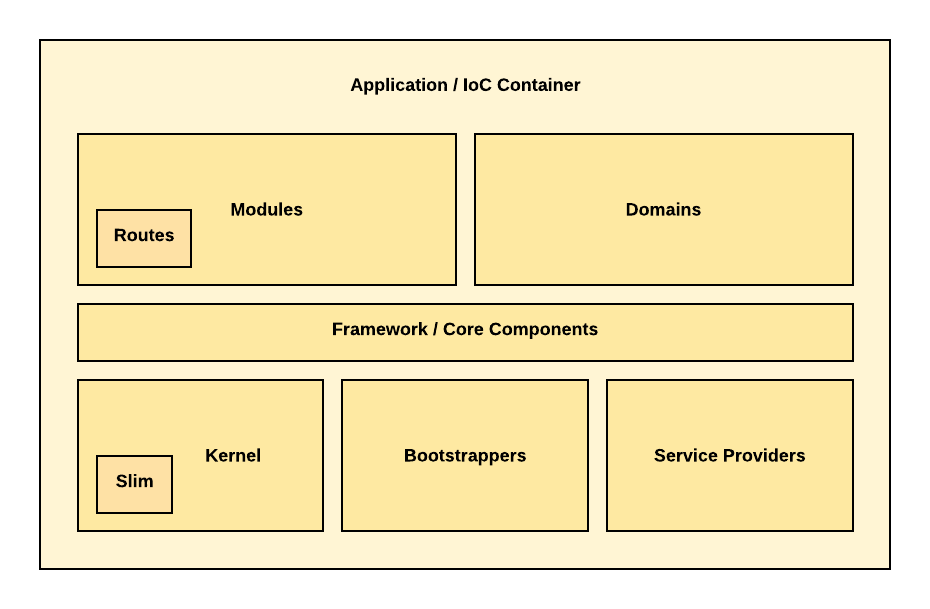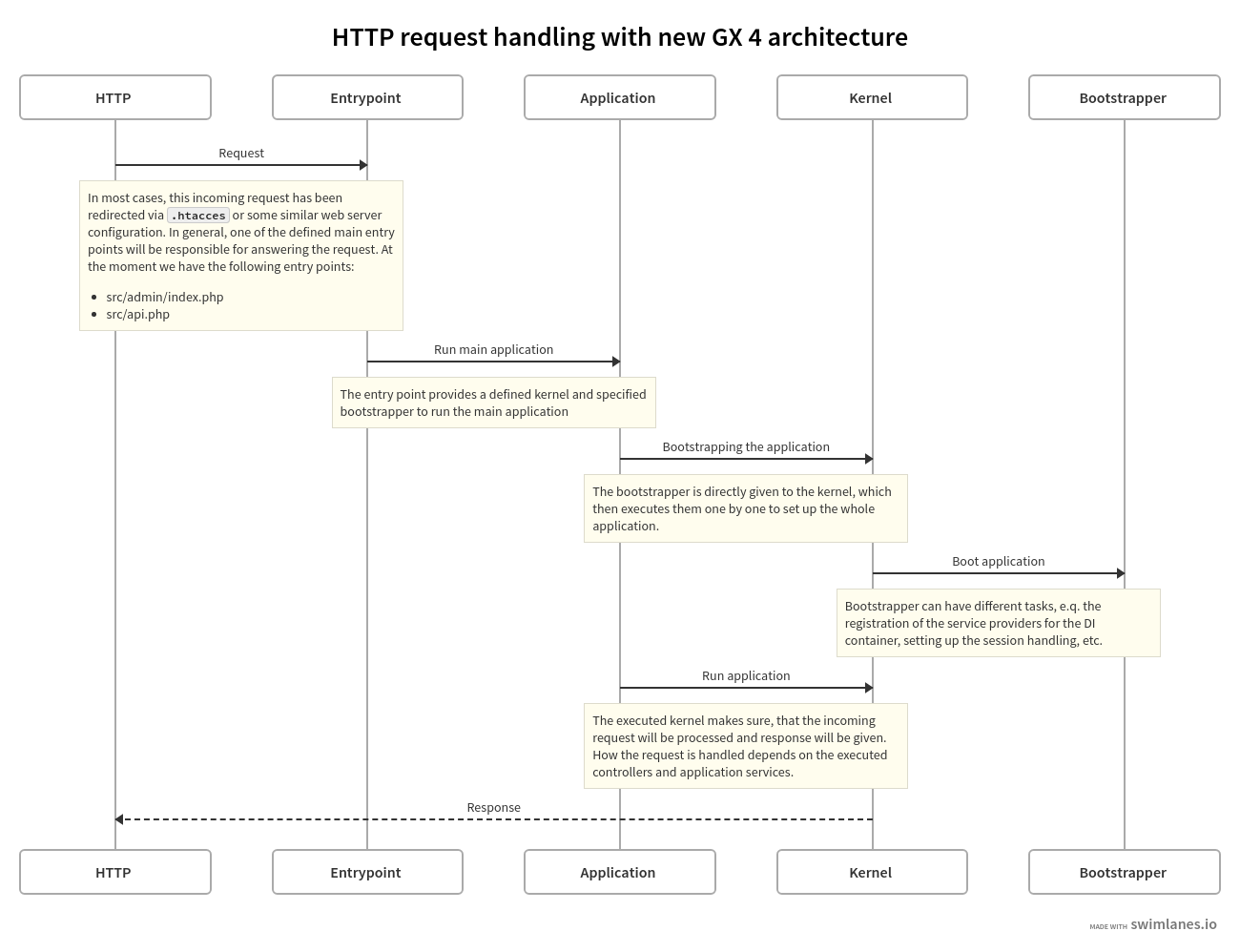Application Core
With the new shop version GX 4, we started developing a new Application Core. This will provide more flexibility and future-proofness to the shop system but it also has far-reaching consequences and changes. We are currently using this new Application Core for parts of the shop software because refactoring the whole shop system will take a lot of time. Whenever the new Application Core isn't used, a previously developed (by us or XTC) architecture is used.
What is an Application Core?
The Application Core (or application) handles all processes that trigger specific functionalities and mechanics of the software, like showing the products page, registering a customer account, or placing an order. Because this software is a web-based application, the triggers are HTTP requests that will be interpreted and processed by internal components of the application. The following picture shows you the essential parts of the Application Core:

Kernel
The kernel is the central component that delegates the start, execution, and finalisation of the application. In the starting process, it uses Bootstrapper to set up the application and delegates to specific application services to handle incoming requests.
Our Gambio\Core\Application\Kernel\HttpKernel implementation is based on the microframework Slim. For execution,
the processing of the HTTP request will be forwarded to Slim, which receives the incoming HTTP requests and starts
the processing that handles these requests.
Another example for a general use case for a kernel would be a CLI program.
Bootstrapper
Besides the kernel, we have the Bootstrappers, which set up the application itself. Each Bootstrapper prepares a part of the application before any HTTP requests will be handled. Typical tasks of these Bootstrappers are the registration of components, handling of HTTP sessions, or registration of routes and middlewares.
Service Providers
We designed the application in a way that it acts as a DI Container; that allows an easy way of Inversion of Control and Dependency Injection. Having a DI Container means that every component or service class used to handle specific functionalities of the application needs to be registered. The container/application will generally arrange the instantiation of these components, services and classes by itself. The Service Providers are the parts of the application responsible for registering these components and services.
Modules
After the application has received an incoming HTTP request and determines which module is responsible, a corresponding HTTP controller or action will be executed. These controllers or actions are part of the module. A single module only provides a fraction of the shop softwares complete functionality. Therefore it uses (and sometimes even contains) a domain.
Domains
Domain is a term of the Domain-driven design and represents a part of the softwares business logic. While an HTTP controller or other components of a module orchestrate processes (e.g. placing an order), the domain contains the inner logic and model of the business itself.
Core components / Framework
The block "Framework / Core components" contains core components that are used by different modules. Systems for caching, logging, or providing language-depended text phrases are examples for these components. They can be seen as the general framework for every module.
The old Application Core
Before version GX 4 (and even still) each page that had been processed by the shop system included one of the following files:
- admin/includes/application_top.php
- includes/application_top.php
- includes/application_top_callback.php
- includes/application_top_export.php
- includes/application_top_main.php
These files can be seen as the old Application Core. They for example included the MainFactory, the old autoloading system, or started the session.
The entry point determines how the application is started and is therefore essential to the Application Core. There were two possible entry points in Gambio Admin before version 4.1:
- Direct call of a file: http://www.example.org/admin/customers.php
- So-called front controller: http://www.example.org/admin/admin.php?do=[Controller name without controller suffix]
Ultimately, both options initially included one of the listed application_top files but handled the page processing differently. The logic was either executed directly in the PHP file or it was delegated to a controller class.
Problems with the old Application Core
The files mentioned above have grown over the years and are hardly maintainable. Decades-old programming paradigms, which are no longer up to date, have been used and thus lead to a significant Bottleneck. Therefore, we have decided to develop a new Application Core.
Differences between old and new Application Core
The new Application Core has been developed from scratch. In doing so, we have adhered to the current PHP standards (PSR's) and integrate modern open-source libraries to meet these standards.
The modernized Application Core forms the basis for all future developments. The goal is to renew all pages with an old Application Core in the next few years, so that in the long term the old Application Core can be removed without any problems.
Because of that we strongly recommend that external developers integrate their functions into the shop system using the new tools. Currently, the new Application Core has only been integrated into a few places in the shop system. We'll replace old areas of the Gambio Admin gradually within the following versions.
With GX 4.1 for example, the REST API v3 as well as the management of parcel services and revocations in Gambio Admin are based on the new Application Core.
Processing HTTP requests
As already mentioned, the task of the Application Core is to process and respond to incoming HTTP requests. The shop system responds to HTTP requests with HTTP responses, which in turn coined the term Request Lifecycle. The browser can render (draw) the desired page, which usually takes only a fraction of a second within the entire cycle.

Developing new core components
The new development of the Application Core meant that not only all previous components but also all services, which we have developed in recent years, could no longer be used in the new system. Therefore, the integration of the new Application Core is a long-term project and we had to develop new core components.
Usage of namespaces
To avoid interfering with third-party developers and our modules, we used several namespaces for the new Application Core, as well as the PSR-4 autoloading of Composer. We introduced the following namespaces and mapped them to the listed directories.
| Namespace | Directory | Description |
|---|---|---|
Gambio\Admin |
src/GambioAdmin |
Contains all components and modules regarding the Gambio Admin |
Gambio\Api |
src/GambioApi |
Contains all components and modules regarding the REST API v3 |
Gambio\Core |
src/GambioCore |
Contains all core components or general framework for every module |
Gambio\Shop |
src/GambioShop |
Contains all components and modules regarding the public Gambio Shop |
GXModules |
src/GXModules |
Contains all components and modules developed by third-party developers, as well as some of our modules |
Notice
If you have downloaded the full version of the shop, the src directory will match the root directory of the shop files.
Differences between new and legacy architecture
The main difference between these two areas is the instantiation and implementation of classes. While the legacy architecture uses the MainFactory to instantiate classes and allow Class-Overloading, the new architecture provides more freedom to implement classes but restricts the possibilities to extend the system. For instance, if you wanted to execute some logic in the legacy architecture, you would have created an overload following specific rules and conventions. Using the new architecture, you would have to create a component or service that does what you wanted to do, register it to the application core using a Service Provider and connect your component or service with an event or command.
Creating a new HTTP controller/action shows the differences as well. The legacy architecture demanded you create
a class extending the HttpViewController or AdminHttpViewController controller and add the suffix Controller
to your class name. The methods inside your controller class needed to start with actions and the HTTP routes would
always be something like <ShopBaseUrl>/shop.php?do=<ControllerNameWithoutSuffix>/<MethodNameWithoutPrefix>. More
importantly, you also wouldn't be able to add dependencies into your HTTP controller using Dependency
Injection but you needed to instantiate your dependency inside the class itself. The new architecture
allows you to create a class as you wish. Sometimes there are classes you need to extend from, but you are free to
use Dependency Injection, define your routes, and aren't bound to naming conventions.